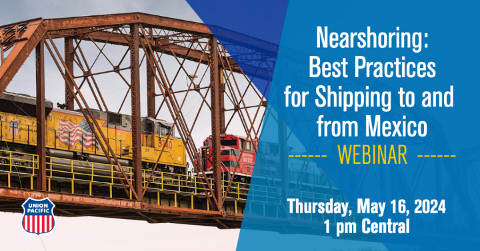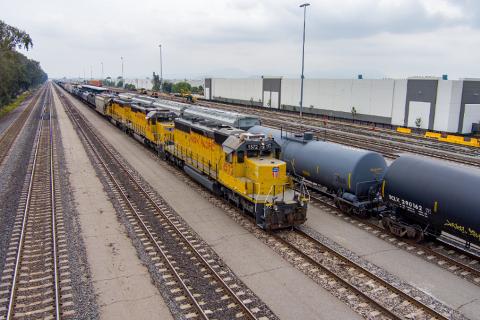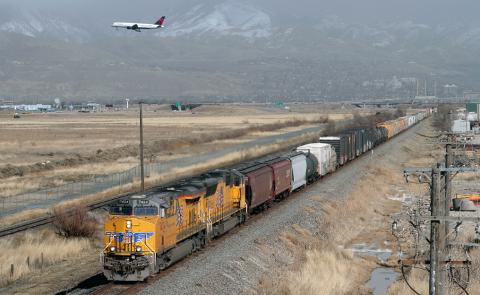You’re sitting at a railroad crossing waiting for a train to pass. As the red lights blink and the train rushes by, have you ever wondered how it got there? And how it did so safely?
The short answer is a train dispatcher, a railroad employee who is responsible for directing the movement of trains within a specified territory. Train dispatching is an important activity, as dispatchers are ultimately responsible for the safe movement of trains across a railroad’s network as well as making sure it’s done efficiently.
What do train dispatchers do?
Put very simply, dispatchers are the people who give trains their orders. They are responsible for ensuring trains and crews move safely and efficiently across a railroad’s network and for making sure no train is delayed unnecessarily.
But before getting in to the specifics of what train dispatchers do, it’s helpful to back up a step and discuss what happens before dispatchers perform their jobs.
Picture a rail yard filled with cars. In order to get those cars ready for their journey, they are blocked (i.e., put into groups based on their destination) and attached to a locomotive to create a train. Then, that train is prioritized — in other words, if two trains need to use the same track, the train’s assigned priority determines which gets to go first. Train priorities are determined by the train type. For instance, passenger trains are typically given highest priority and manifest trains (trains with various car types destined for various customers) the lowest. Once trains are blocked and prioritized, all of this information is entered into a system. That’s when the train dispatcher steps in.
The dispatcher takes this information and uses it to give trains their orders: when they are allowed to leave the yard, how far they are allowed to travel and how fast they can travel (this is called “limits of authority”). A dispatcher’s job is very similar to an air traffic controller’s except they manage trains on the ground instead of planes in the air.
How do dispatchers make sure trains move safely? Dispatchers clear signals so trains can move safely through a specific territory. Just like stoplights let drivers know if it is safe to proceed through an intersection, red, yellow and green signals tell a train conductor whether it’s safe to proceed on a section of track. Dispatchers control these signals and therefore, grant a train authority to proceed. If there are multiple trains in the area, dispatchers makes sure the train with the highest priority moves first — and they make sure trains that must run on the same track don’t collide.
Each dispatcher is responsible for a specific territory and it’s his or her job to ensure a train moves safely from one segment of a territory to another. To do so, they have to be experts in all of the factors that can affect safe and efficient train operation, including the type of operating territory and geographic, weather and local restrictions in that area.
Because train crews can only work a maximum of 12 hours at a time (also referred to as “hours of service regulations”), dispatchers must also make sure crews can complete their work in the 12 hours they are allotted to work.
Dispatchers also grant authority for engineering professionals to repair track. For instance, if a welder needs to repair a segment of track, dispatchers know not to give any train authority to move past a certain point on their track in order to ensure the safety of the engineer. So in addition to supervising train movement, dispatchers also supervise work done on tracks.
How are dispatchers trained?
Perhaps the most appropriate word for how dispatchers are trained is “thoroughly.” At Union Pacific, the time between the date a dispatcher is hired and the time he or she operates on their own is typically about a year. For the first six months, dispatchers receive a combination of classroom and on-the-job (OTJ) training, then they are tested on their skills. Only those who score 95 percent or higher on proficiency tests continue on. Those who do then undergo a six-month monitoring period before they’re allowed to perform the job on their own.
Why is training so thorough? Train dispatchers are responsible for keeping train crews and engineering professionals safe, as well as ensuring safety in the communities through which trains travel. When human lives are at stake, training must be taken very seriously.
Where do dispatchers work?

The Union Pacific Harriman Dispatching Center in Omaha, Nebraska
The location of dispatchers vary from railroad to railroad, but they are usually centralized in a large dispatching center that is supported by smaller satellite locations. Dispatching never stops, so main dispatching centers operate 24 hours a day, seven days a week. At Union Pacific, most dispatchers work at the Harriman Dispatching Center in Omaha, Nebraska, an historic brick building originally constructed in 1891 as a freight house. Nearly 100 years later, the freight house was repurposed as the nation's first centralized dispatching center. A reinforced concrete bunker houses the train dispatchers, their computerized equipment and the train management team. Union Pacific also operates satellite dispatching centers in Spring, Texas, Kansas City, Kansas, and San Bernardino, California. Altogether, it takes about 350-400 dispatchers to keep the entire Union Pacific system moving.
What systems do train dispatchers use to dispatch trains?
Centralized Traffic Control
The system used to dispatch trains varies from railroad to railroad, but in general, dispatching systems (also referred to as Centralized Traffic Control) allow dispatchers to see a segment of track, the location of a train or trains, and the status of the signals along that section of track.
For instance, Union Pacific Railroad uses a system called CADX, a newer, more automated system than what has been used historically. In the past, dispatching relied on keystrokes input by dispatchers, similar to typing on a keyboard. Today, the system is run by mouse clicks to reduce the chance of human error and to allow dispatchers to manage their territory in a safer, more efficient manner.
For the most part, train movements are automated using sophisticated algorithms. But at times, dispatchers must step in and make critical decisions that promote safety and efficiency. For instance, if a train experiences a mechanical breakdown, the delay may cause the crew to run out of hours of service before reaching their destination as originally planned. When this is the case, dispatchers must intervene, reprioritizing the movement of trains so crews can complete their journey before their hours of service are up.
Signals
If you’ve ever seen something that looks like a stoplight alongside a railroad track, that’s a signal. Just like traffic lights, railway signals tell conductors whether it is safe to proceed. A green light means it’s safe to proceed. A red light means a train is not allowed to proceed. And a flashing yellow light means a train must slow down. Typically a conductor will see two flashing yellow lights before reaching a red, giving the train ample time to come to a stop. Dispatchers control these signals.
Although rare, sometimes trains will travel through “dark territory” — portions of track that are not equipped with signals. In these instances, dispatchers will give conductors specific instructions about how to proceed and at which milepost to stop. In these situations, it is the conductor’s responsibility to pay careful attention to the mileposts to ensure the train does not travel into unsafe territory.
Positive Train Control
Positive Train Control (PTC) also plays into the picture. Positive Train Control calculates train stopping distances and prompts locomotive engineers to slow down based on each train’s weight, length, speed and track terrain. This sophisticated safety system automatically stops trains if engineers do not respond in a timely manner, preventing certain accidents caused by human error, including train-to-train collisions. When locomotives are equipped with PTC, conductors are able to see signal information in the cab of the locomotive. Although conductors can see signals on screen, they are still instructed to follow the signals they see alongside the track (called “on-mast signals”) or overhead on signal bridges. It’s important to know that Positive Train Control is a failsafe to prevent train collisions, not a dispatching system, but it does have the ability to control train movement in potentially dangerous situations.

A snapshot of Union Pacific's CADX dispatching system. The lines represents the track. The red line with the arrow on the left of the screen is the train itself. The green lines represent the authority ahead of the train (the area through which it is allowed to travel). The red and green circles represent signals. This screen shot represents a train meet, where one train must pull into a siding (in this instance, at the Orchard siding) so the other can pass.
Thank You, Dispatchers
Dispatchers have a difficult job, but one that is incredibly important. They play a very important role in keeping freight moving across North America and moreover, making sure it’s done safely. For that, we thank them!
Learn More
To learn more about how trains are dispatched or how to ship by rail, get in touch. Or, check out these Train Dispatching Terms to take a deeper dive into the language of train dispatching.
Related Articles









